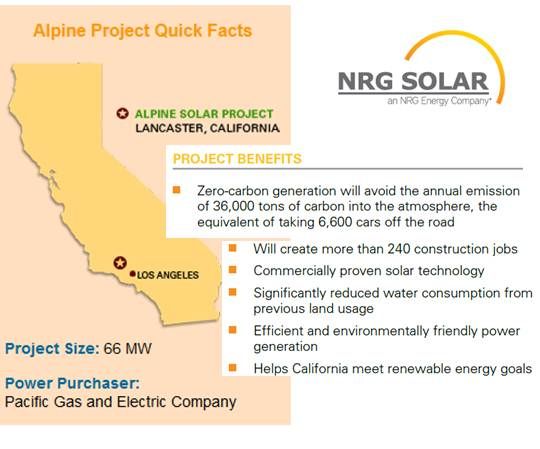Many people in California’s Antelope Valley, one of the state’s sunniest places, have a slightly different take on solar energy compared to renewable energy advocates in energy-hungry cities.
As they watch solar power plant developers gobble up the wide open spaces in their high desert landscape, they wonder why people in San Francisco and Los Angeles aren’t putting solar panels on their rooftops instead of sending corporations to intrude on their quiet rural lives and make them pay a far greater price for climate change than the cities’ polluters.
Antelope Valley’s solar resource is special. Pacific winds blow through the Tejon Pass, pushing any cloud cover off to the Tehacapis or the San Gabriels and opening the desert floor to dawn-to-dusk sunlight on well over 300 days of the year.
It’s an asset solar developers and California’s political leaders, intent on generating a third of the state’s power from renewables by the end of this decade -- and reaping the economic rewards that will come from doing so -- can’t resist.
Arbitrating between the locals and the leaders are people like Keith Latham, NRG Solar Vice President of Development.
Latham, an engineer, moved from overseeing fossil fuel plant permitting four years ago to overseeing solar power plant development. He joined NRG two years ago.
In late 2009, Latham and NRG Solar took over a claim in the valley staked initially by eSolar for a solar power tower project. Amid the economic downturn, eSolar’s little-tested technology became unbankable, while rapidly falling silicon prices made an NRG photovoltaic (PV) panel installation an appealing deal for the 640-acre site.
Latham came into the Antelope Valley equipped with diplomacy and bargaining chips.
The first order of business was renegotiating the power purchase agreement (PPA) that eSolar had with Pacific Gas & Electric (PG&E). “It was a process they were willing to work through,” Latham said of the utility’s willingness to turn to PV.
Next came the permitting process and obtaining a transmission interconnection, which Latham saw through by December 2010. NRG’s Alpine Solar became a 66-megawatt, phase 1 PV project on 400 acres of the site. An additional 26 megawatts, already permitted and with a ready interconnection, may be built on the remaining acreage as phase 2.
But the permits and the interconnection, although often a project’s most challenging hurdles, turned out to be only the beginning for Latham.

“As part of the permitting process, we needed to involve the community,” Latham explained, and that, he said, “has been a widely varying dynamic since we started the process.”
Latham said, “We were [initially] working with Antelope Acres Town Council, the only town council we were aware of within a reasonable distance of our project.” But at the end of 2010, about the time the Alpine Solar permits were being granted by the County of Los Angeles, “the Fairmont Town Council came into existence,” Latham said. They and Friends of Antelope Valley Open Space, a local environmental group, appealed the permits.
To sort out the thorny issue of which body they should work with to legitimately negotiate local issues, Latham said, “We spent a lot of time in the area. We started setting up regular meetings with the Fairmont Town Council and the community. We were regulars at their town council meetings and really tried to work with them to identify the needs of the community.”
Latham made weekly trips to the region, spent a day or more on each visit, and pointedly engaged in discussions with those he identified as key stakeholders. Through this time-intensive process, he came to understand local concerns.
Latham first assured the communities he would not cut down a locally treasured stand of trees. Then, at their urging, he chose to reduce the height of the security fences from eight feet to six feet and to line the fences with aesthetically appealing staggered double rows of afghan pines, which thrive in the high desert.
Latham also voluntarily set aside about 50 of the site’s unused 240 acres to help protect the valley’s burrowing owl population. “It was an environmentally sensitive area, so it just made sense,” Latham said, “to make it secure instead of messing up a habitat.”
But these concessions were really just overtures. Sources who did not want to be identified revealed to Greentech Media that NRG Solar committed to pay nearly a half million dollars in cash and land to each of two of the local town councils over the coming 20 years.
Latham confirmed that NRG had concluded formal agreements with both the Fairmont and Oso Town Councils but would not comment on financial details. “The terms are confidential,” Latham said.
Latham’s efforts won allegiance from community leaders. Fairmont Town Council President Dave Kerr described him as “a pleasure to work with” and “most unlike the ‘used car dealer types’ from the other solar company in the area.” Kerr also said he hopes “Keith will do other projects here in the future.”
By mid-October, Latham said, he expects to have an executed agreement with another company to build and operate the Alpine Solar project. NRG Solar estimates it will provide over 240 construction jobs and Latham said he intends to make sure these positions go to locals.
As to what advice Latham would offer other developers looking to win over reluctant locals, Latham simply said, “Spend time in the community to understand the people and what’s of value to them.”



